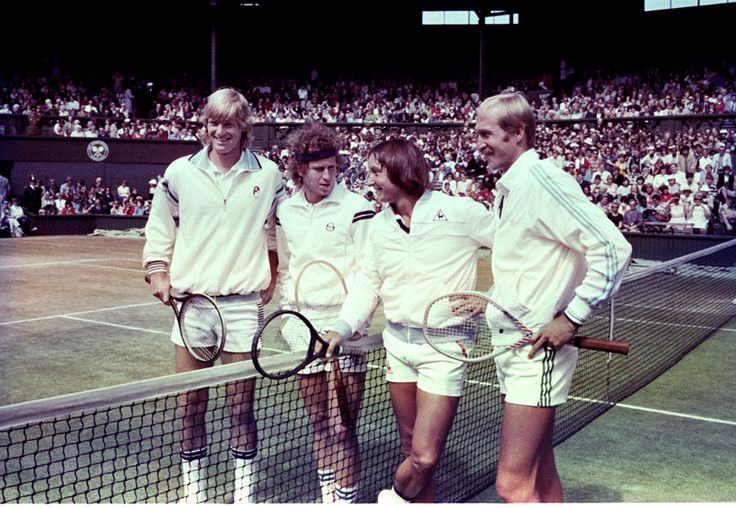For the May 1973 issue of Tennis magazine, five-time US national doubles champion George Lott rated the ten best doubles teams in history. He had plenty of respect for his pre-war peers–Vinnie Richards made the list with two different partners–but he wasn’t afraid to give credit to the strongest lineups in the modern game.
Atop Lott’s list was the Aussie duo of John Newcombe and Tony Roche, winner of ten major titles up to that point. Four more contemporary Aussies made the list: Rod Laver and Roy Emerson came in at sixth, while Ken Rosewall and Lew Hoad ranked tenth.
Missing from the table–an omission Lott might have corrected had he revisited the list a few years later–was the American pair of Stan Smith and Bob Lutz. The two men had led USC to national championships the late 1960s, then burst onto the pro scene with a title at the 1968 US Open. They missed a few years’ worth of opportunities to team up–especially in Davis Cup–because Lutz joined the World Championship Tennis circuit before Smith did. When Stan finally switched sides for the 1973 campaign, the duo could reunite on a full-time basis.
WCT didn’t just have a tour-ending championships–coming up in the second week of May–it had a wholly separate doubles event. This one was held in Montreal, and the winning team would collect $40,000, the richest-ever prize for a doubles-only tournament. Smith and Lutz, with two tournament victories on the season, were the top seeds in their group.
On May 3rd, the American duo overcame a barrage of bad line calls to defeat Niki Pilić and Allan Stone in a four-set first rounder. Two days later, Lutz took the starring role over his better-known partner as the team withstood Laver and Emerson in a four-set match that went through three tiebreaks.
The title match, on May 6th, was a cakewalk by comparison. The challengers, Marty Riessen and Tom Okker, had played well past midnight to defeat Rosewall and Fred Stolle in the semis. Less than 12 hours later, they were back at it. But not for long: Smith and Lutz took the final, 6-2, 7-6, 6-0. Riessen and Okker had to settle for a mere $8,000 apiece.
Where, George Lott might have asked, were Newk and Roche? Roche was coming back from injury, playing a minor-league circuit in the States. Newcombe had taken a break from the weekly grind of World Championship Tennis, so he was ineligible for the big bucks in Montreal. Instead, he was spearheading a group of countrymen in Asia as they fought to regain the Davis Cup. Laver, Emerson, Rosewall, and Stolle were probably more concerned with the action half a world away in India than they were with their own results in Canada.
Concerned–but not worried. After a scare in Hong Kong a couple of weeks earlier, the Aussies were ready for Vijay Amritraj, the dashing Indian youngster. Amritraj and his teammate-brother Anand had the home court advantage in Madras, but not much else. On the first day of play, Newcombe and Mal Anderson conceded just seven games in six sets. While the doubles rubber was closer and the humid conditions favored the hosts, Newk and Geoff Masters sealed the tie in four sets.
The Australians’ relief was two-fold. Indian security forces were concerned that Pakistani terrorists would attempt to kidnap the athletes, a particularly vivid threat just eight months after a massacre of Israeli Olympians in Munich. The visitors were guarded by machine gun-wielding troops, so Newcombe and his teammates spent the trip hunkered down in their hotel rooms. Somehow they managed to muster the focus to get through the tie.
Now, both groups of Aussies–Newk and his buddies at home in Oz, and the WCT crew in North America–could sit back and wait. They had a place in the Inter-Zonal semi-finals, to be contested in November. They wouldn’t even know their opponent for months. Davis Cup ties were spread all over the Continent this weekend: Bulgaria beat Belgium, Norway stopped Denmark, and New Zealand snuck past Austria, to name just three. It was just the beginning: There were three more rounds to go before a European side earned a place against Australia. Davis Cup wasn’t just a measure of skill, it was a test of commitment.
That test was a little tougher to pass each year. Who–aside from Newcombe–would pass up a shot at $20,000 to play a Davis Cup zonal tie in India? Smith captured the ambivalence in a post-match interview. “I suppose it’ll be kind of nice,” he said, “to tell our grandchildren some day that we won the first doubles championship.” After all, the poor kids will be begging for something different after the 100th telling of how Grandpa and his friends won the Davis Cup.
* * *
This post is part of my series about the 1973 season, Battles, Boycotts, and Breakouts. Keep up with the project by checking the TennisAbstract.com front page, which shows an up-to-date Table of Contents after I post each installment.
You can also subscribe to the blog to receive each new post by email:
